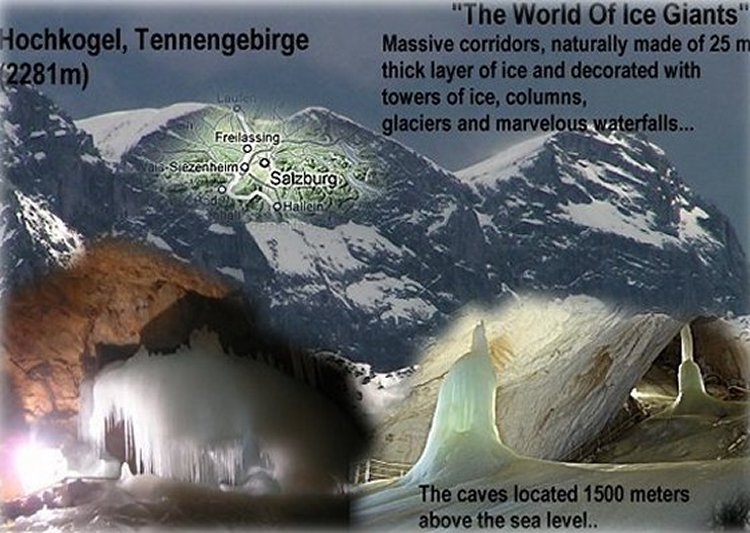World of The Ice Giants’ – Magnificent Underground Labyrinth Of Caves
MessageToEagle.com – There are over one million caves on our planet but only very few of them are ice caves.
Magnificent underground labyrinth of caves, extending more than 42 km (26 miles), are located outside of Salzburg, Austria. It’s the largest known system of ice caves in Europe.
They represent some of the largest of their kind, but only one kilometer of the caves can be visited under supervision of a tour guide.

“World of the Ice Giants”, (in German “Eisriesenwelt”) is a magical, underground realm, with long history stretching back over 50 to 100 million years, but ice formations are a recent, approximately 1,000 years old phenomenon.
The caves located 1500 meters above the sea level, are a genius work of the Salzach River, sometimes called “Salzburg River” and… time. These two natural “artists” carved holes, icy alcoves and passageways in the mountains.
And so began the existence of the “World of the Ice Giants”, a very beautiful place but also dangerous, difficult to get to and as a result, not visited particularly often by tourists.
During the winter time, the temperature in the caves drops significantly. The rain and the water resulted from the melted snow penetrate this underground dark and foggy interior and freeze instantly.
The wonders of the “World of The Ice Giants” are concentrated within massive corridors with walls, of which many are more than 100 feet wide, 100 feet high, and 70-80 feet thick.
The ice walls, where the average temperature is below zero, are decorated with towers of ice, columns, glaciers and marvelous waterfalls.
The icy labirynth is located in the west wall of the Hochkogel in the Tennengebirge, in the Northern Limestone Alps, just in front of the Eastern Alps. The area is a huge block of limestone with steep rocky slopes to all sides and a large plateau that covers approximately 45 square kilometres.
It is rather a terrain, with high peaks, which does not offer easy climbing especially because at the higher altitudes, the paths are often hard to find.
There is, however, a stair system with 1400 steps, covering a height difference of 136 meters. Those who had an opportunity to reach the “World of Ice The Giants” can walk up and down these stairs and admire beautiful stalagmites and stalactites.
With help of small open carbide lanterns – the only light used in the cave’s interior – the visitors can see ice layers colored by minerals in the water.
Once upon a time, the “World of Ice The Giants” was believed to be the entrance… to hell.
It was first discovered in 1879, when a natural scientist from Salzburg, Anton Posselt, decided to continue his search into the darkness of the caves and at last, the Eisriesenwelt was officially discovered.
One year later, Posselt published an enthusiastic and very detailed report of his discovery but no one took any notice of it and the caves again slipped back into obscurity.
Was it a lack of interest in further exploring of these impressive ice caves? Although, Anton Posselt was the official discoverer of the caves, he was not the first one. Certainly, the locals were well aware of their existence for long, but no one had never wanted to explore their interior and avoided the place.
One of the few people who wanted to continue Anton Posselt’s exploration of the caves was Alexander von Mörk, a speleologist from Salzburg who led many expeditions into the caves and charted the labyrinth of ice chambers. Von Mörk was killed in World War I in 1914, about a year after he explored the caves.
An urn containing his ashes can be seen inside a niche in the “World of The Ice Giants”, in the 120-foot-high ice chamber known as Alexander von Mörk Cathedral.
The “World of The Ice Giants” are more than normal caves. Once inside them, one has a special feeling as the whole place is not of this world.
Copyright @ MessageToEagle.com All rights reserved. This material may not be published, broadcast, rewritten or redistributed in whole or part without the express written permission of MessageToEagle.com










